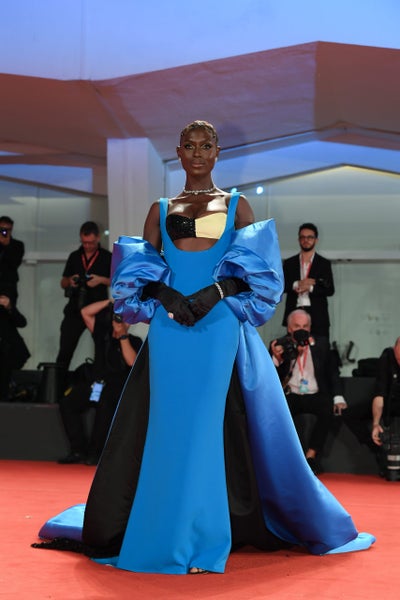
[ad_1]
Some designers operate from a product standpoint, whereas others operate from a holistic space. Charles Harbison is the latter. His design practice is likened to that of a curatorial practice. He ideates first from a point of reference, then extracts that reference into color stories, culminating in the collection. Through his eponymous label, Harbison, he’s creating his own universe. It’s one full of color, an artisanal touch, and a wonder emporium of curiosity.
It’s no wonder his designs have captured the attention of everyone from Beyoncé and Cynthia Erivo to Storm Reid and Amanda Gorman — they exude a certain timelessness. His most recent resort collection harkens back to silhouettes of yesteryear, with bustles, balloon skirts, opera gloves, and voluminous capes with trains. It perfectly nods to the past while being incredibly fresh and of the moment. That’s all a part of the magic!
ESSENCE sits down with the cerebral, LA-based designer to talk all things fashion, the process of relaunching his eponymous label, inspiration, Sam Gilliam, and his advice for the new vanguard.
Second Time Around:
“This go-around, I have more focus. The first time around, everything was an option, and I approached the business kind of like a bright-eyed kid, excited to try and test things. I also had a certain curiosity and impressionability. But this time around, I feel wiser and also a bit disillusioned — in a healthy way. I’m a bit clearer today about the kind of business I want to build and clear on the mechanics I need to employ in order to build it.”
On Inspiration:
I’m in such a boring space. I’ve been listening to so much classical music. A lot of modern classical like Steve Reich and Philip Glass, who’ve always been favorites of mine. I listened to [Philip] Glass as a student, and it really changed my life when I was 18 years old. I’ve always appreciated repetition and patterns in my work, which I heard reflected audibly in Glass’s work. And so listening to that canon of classical music lately has been really inspiring to me.
Also, at this point, I’ve been able to engage with so many amazing women. I’m not having to create figures in my mind anymore to design for, I’m looking at these women, you know, and I’m actually engaging with them, and they’re engaging with my clothes. That is super inspiring. Aside from that, I bought some Sam Gillean books, and my mind is blown. I knew the work and have engaged with it over the past few years (it was a key point of inspiration for the last two collections), but you know, with his passing, I approach it differently. I think this is, unfortunately, what happens, but also, fortunately, what happens when artists leave us we begin to kind of engage more diligently with their work work. So, I’ve been engaging more diligently with the breadth of work. It’s so expansive!
Creating A Safe Space:
My work is actually my escape, and I love going there. In fact, I actually have to pull myself out and engage with the wider world. That’s the thing that is more difficult for me. Instead of having to go in and tear myself away from the world at large, I love to stay in. To stay in this Daydream, this fantasy that little Charlie created as a safe space, and it’s still my safe space today!
Ideation:
The design process for me starts from stories and things I’ve read, memories, narratives, concepts, and plotlines. I need to feel emotionally connected to an idea. And then, really, in tandem, I’m engaging with color/color theory I’ve extracted from that story, mood, and then fabrics and how those colors and feelings engage with said fabric. At that point, I go on the opposite side where I’m working in a bit more utilitarian and entrepreneurial way where I’m thinking, “okay, what does she or he or they need from me?” What has been working in the collection? How can the collection evolve? And then, at that point is when I can start putting pen to paper and sketching.
Fashion Eco-System:
If we’re not engaging with fashion in this kind of sustainable, intellectual way, then we relegate it to something passing and dismissive. And the ramifications of that are not only bad for the creators themselves, but it’s also bad for the market and bad for the environment. So the ramifications are far-reaching for us not appreciating the fact that dressing is a key tool that we use culturally, anthropologically, and socially to present ourselves to the world and have done so for centuries.

Advice:
My biggest piece of advice is always to do what you do exceedingly well.
I believe in product, and I believe in excellence. And when it comes to design, it’s about the customer, their experience, and how they engage with what you create. Don’t get distracted by the industry and the theater of the industry to the degree that you lose your focus on your customer, the product, and the fact that they are going to continue to come back to you when the thing that you create is excellent.
Legacy:
My goal is to be in vintage stores. My goal is to contribute to the canon of fashion. My goal is for my name to be mentioned in fashion history.
[ad_2]
Source link





